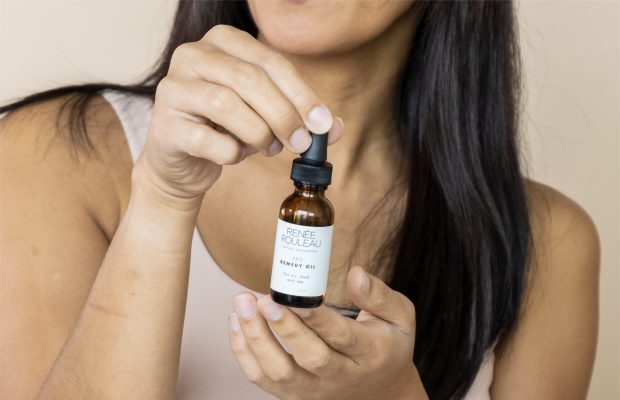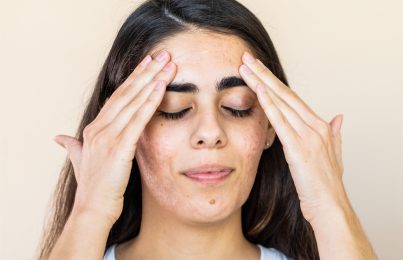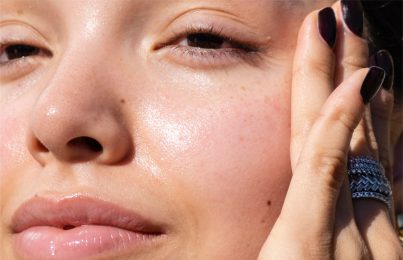Updated 10/9/23. Whether or not you use face oil probably depends on your skin type. If you have a dry skin type, chances are that you use them often. If you have an oily skin type, chances are that you avoid them altogether. I’m here to tell you that most skin types can benefit from face oil (yes, even oily, breakout-prone skin types!). You just need to know how to use them correctly.
You might think there’s no room for error when it comes to face oil, but trust me, there is! I’ve been an esthetician for over 30 years, and I constantly see people use them incorrectly. It’s a shame, because it’s not letting them get the most out of their products, and it’s definitely not doing their skin any favors.
In this post, I’ll explain how to apply face oil the right way so you can avoid some common mistakes. Let’s get into it!
When to Use Face Oil
In general, I recommend using face oils in the evening. This is because your skin kicks off its natural repair processes when the sun goes down, and an oil can help support these processes. (Learn more about your skin’s circadian rhythm.) Also, the air is usually dry at night, and an oil can help prevent transepidermal water loss, or TEWL, which is when the air pulls moisture from the outer layers of your skin.
A big reason why I don’t recommend using face oil during the day is sun protection. Oils can disrupt sunscreen, making it less effective at protecting the skin from damaging UV rays. Since the main goal of your morning skincare routine should be sun protection, it doesn’t make much sense to introduce a face oil. In fact, this is one of the five most common sunscreen mistakes I see people make.
The only time I recommend using a face oil during the day is when you’re traveling in an airplane and you want to prevent water loss (but more on that in a minute).
How to Apply Face Oil The Right Way
Here’s how to use face oil properly. In the evening, as the last step in your routine, take 2-4 drops of face oil and press it into the skin. Face oil should never be applied before moisturizer or in place of moisturizer. That goes for all skin types. Let me explain why.
Oily, Blemish-Prone Skin
Oily, blemish-prone skin types (like Skin Types 1, 2, 3, & 4) usually produce enough oil. What they need is water. When you use a moisturizer for oily skin, it’s generally lightweight and oil-free. You want these ingredients to absorb into your skin first, so you get the hydration your skin needs. Then, you can add oil over the top to seal it in and prevent that TEWL I talked about earlier.
If you mix face oil in with your moisturizer or use it in place of your moisturizer, you could cause problems for your skin for a couple of reasons. First, you could be preventing your skin from getting the hydration it needs. Oils are made up of large molecules, so if you apply them first, they could block your other products from penetrating through to your skin. Second, you could cause even more breakouts to form because you’re adding oil directly to your skin and not just as a top coat or sealant.
Normal Skin
Normal skin, like Skin Types 5 & 6, has a good balance of oil and water, which means it’s not dry and it’s not dehydrated (learn the difference!). You want to keep it that way, so avoid using face oil before moisturizer or in place of it. This could throw off that balance, giving your skin more oil than water.
Additionally, moisturizers often contain other beneficial ingredients such as antioxidants and peptides. You want to make sure these can penetrate through to the skin, which is why you should always use moisturizer before face oil! Once moisturizer is applied, pat a few drops of face oil over top to seal that moisture into the skin and give your complexion a nice glow.
Dry Skin
Dry skin (like Skin Types 7, 8, & 9) doesn’t produce enough oil. This affects the moisture barrier, causing tiny cracks to develop. These tiny cracks let moisture escape and irritants enter. Using a well-formulated face oil is a great way to avoid this! In fact, if you have a dry skin type, I highly recommend incorporating face oil into your routine. Your skin needs it to look and feel its best.
Even though dry skin needs oil more than water, you should still only use it as the last step in your evening skincare routine. Using it before or in place of your moisturizer can throw off the water levels in your skin (and that’s the last thing you want! Remember, it’s all about balancing water and oil). Also, you might miss out on the additional ingredients often found in moisturizers, like antioxidants and peptides. As I explained before, the large molecules that make up the oil can act as a barrier, preventing smaller molecules like those in moisturizers, from penetrating through to the skin.
Don’t know your skin type? Take the Skin Type Quiz to find out! Simply answer a few questions, and you’ll get detailed information about your skin as well as personalized product recommendations. It takes the guesswork out of skincare.
How to Use Face Oil on an Airplane
The air in airplane cabins is notoriously dry (check out this experiment I did for proof!), and it will take it out of your skin if it can. Since face oil acts as a sealant of sorts, it will create a barrier between your skin and the air and prevent moisture loss during long flights. Cool, right? Simply apply 1-2 drops of face oil over moisturizer every hour during your flight. This will keep your skin happy and hydrated, no matter how long you’re in the air.
Don’t just apply it once before your board. Your skin needs a continual application to keep the barrier intact, especially during overseas flights, when you’re exposed to the drying cabin air for hours and hours.
The Face Oil I Recommend Using
Without a doubt, I recommend using Pro Remedy Oil. I formulated it with a combination of 12 lipid-rich oils to moisturize the skin, soothe irritation, and support the natural skin barrier. There’s also vitamin C to help keep the skin protected from damaging free radicals. As for the texture of this product, it’s smooth, silky, and lightweight, so you don’t have to worry about it leaving a heavy, greasy residue.
It’s the face oil I personally use and recommend to all of my clients.
The Bottom Line
Face oil can benefit your skin, no matter your skin type. You just have to use it correctly. Think of it as a top coat or sealant for your skin. If you use it as the last step in your routine, it will work like a bodyguard, keeping moisture locked in, right where it should be!
Next, find out whether slugging is the solution to your damaged moisture barrier.
Celebrity Esthetician & Skincare Expert
As an esthetician trained in cosmetic chemistry, Renée Rouleau has spent 30 years researching skin, educating her audience, and building an award-winning line of products. Her hands-on experience as an esthetician and trusted skin care expert has created a real-world solution — products that are formulated for nine different types of skin so your face will get exactly what it needs to look and feel its best. Trusted by celebrities, editors, bloggers, and skincare obsessives around the globe, her vast real-world knowledge and constant research are why Marie Claire calls her “the most passionate skin practitioner we know.”



